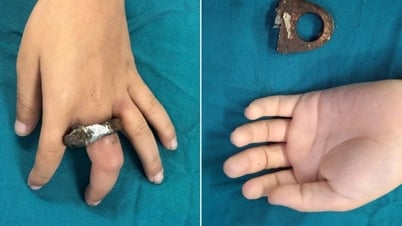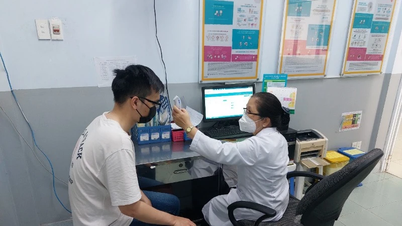Overweight but still malnourished children
The situation of “energy satiety but micronutrient starvation” is becoming more and more common. Children consume too much energy-rich food but poor in micronutrients, leading to overweight and obesity while still lacking essential nutrients such as iron, calcium, vitamin D, etc.
To prevent and improve obesity, parents need to develop a diverse, nutrient-rich diet. |
According to the National Nutrition Survey 2019 - 2020 by the National Institute of Nutrition, the rate of overweight and obese children in Vietnam has increased 2.2 times within 10 years - from 8.5% in 2010 to 19% in 2020. At the same time, about 60% of children under 5 years old are zinc deficient and one in three children is iron deficient.
Obesity malnutrition is a special form of malnutrition. Children may look chubby but lack essential micronutrients such as iron, calcium, vitamin A, D... due to an unbalanced and undiversified diet.
The common cause is that children consume too many energy-rich foods such as fried foods, fast foods, candy, and soft drinks, but very few foods containing vitamins and minerals.
Some children eat a lot of carbohydrates (such as rice, cakes, condensed milk) but lack meat and fish - a necessary source of protein, causing anemia and slow physical development.
In addition, not being breastfed enough in the first 6 months of life - a natural source of nutrients rich in iron, calcium and antibodies - also increases the risk of micronutrient malnutrition.
Children who are sedentary and spend a lot of time watching electronic devices cause excess energy to accumulate into fat, while the body does not develop proportionally in terms of bones, muscles, height or immune system.
The case of a 7-year-old girl, the daughter of Ms. Ngoc Linh (34 years old, Ho Chi Minh City) is a clear example. Although she is plumper than her peers, when she came to the hospital for examination, she was diagnosed with iron, calcium, vitamin D and A deficiency. Similarly, Ms. Ha's 4-year-old son ( Dong Nai ), weighing 22kg, was also found to be anemic and rickets despite eating well.
After three months of applying a scientific diet, supplementing missing micronutrients and exercising according to the doctor's instructions, the health of the two children improved significantly. Test results showed that micronutrient indices gradually returned to normal levels.
Doctor Yen Thuy, MD.CKI Dao Thi Yen Thuy, Head of the Department of Nutrition and Dietetics, Tam Anh General Hospital, Ho Chi Minh City, warned that many parents still hold the notion that "plump children are healthy", leading to the abuse of formula milk, nutritious foods such as bird's nest, bird's nest, high-quality proteins, forgetting the factor of nutritional balance.
“Gaining weight does not mean being healthy. Children can gain weight but still be anemic, have rickets, have slow growth or be at risk of chronic diseases later in life such as diabetes, cardiovascular disease, and high blood pressure,” Dr. Thuy warned.
To prevent and improve obesity, parents need to create a diverse, nutrient-rich diet. The menu should include vegetables (rich in fiber and vitamins), meat, fish, seafood, beans (providing protein, iron, calcium), and healthy fats from vegetable oils. Prioritize steaming and boiling instead of frying to preserve micronutrients.
Avoid giving your child too much processed food, sweets, and carbonated soft drinks. Do not force your child to eat a lot of one food, but encourage them to eat a variety of foods at each meal.
In addition, it is necessary to ensure that children exercise at least 30 minutes a day: walking, running, cycling, playing sports ... to improve health, burn excess energy and develop muscles and bones.
Parents need to pay attention to signs such as: pale skin, fatigue, hair loss, rough nails, easy illness... These could be signs of micronutrient deficiency.
Cirrhosis, heart failure due to congenital heart disease without knowing
Having congenital heart disease since birth but not knowing, by the time it was discovered it was too late to intervene, that was the case of Ms. Thu, 54 years old, hospitalized in a state of severe heart failure, cirrhosis due to complications from the remaining ductus arteriosus.
Ms. Thu was diagnosed with heart failure and pulmonary hypertension many years ago. However, because the exact cause could not be found, she was only treated with medication to treat the symptoms. Recently, her condition has worsened: she is often tired and has difficulty breathing even when not doing heavy work, and even has to sleep sitting up because she cannot breathe when lying down.
At the hospital, she was admitted on April 11, 2025 in a state of fatigue, generalized edema, enlarged liver and severe shortness of breath. The results of the echocardiogram showed severe impairment of cardiac contractility (EF only 23%), severe pulmonary hypertension and signs of cardiac cirrhosis - liver damage due to prolonged blood congestion.
Surprisingly, doctors discovered she had a large ductus arteriosus - a congenital heart abnormality that had gone undetected for more than 50 years.
According to Master, Doctor, CKII Huynh Thanh Kieu, a cardiovascular specialist, the ductus arteriosus is a normal part of the fetal circulatory system, which will usually close on its own within the first few days after birth. If it does not close, the defect is called Patent Ductus Arteriosus (PDA).
When there is a patent ductus arteriosus, blood flows back from the aorta into the pulmonary artery, increasing the burden on the heart and lungs. If the defect is large and left untreated for a long time, it will cause serious complications such as pulmonary hypertension, heart failure, endocarditis, and cardiac cirrhosis, as in Ms. Thu's case.
“This case is very unfortunate because the patient lived with a congenital heart defect without knowing it. By the time it was discovered, the disease was already in a late stage and surgical intervention was not possible due to the high risk of death,” said Dr. Kieu.
Currently, there are two methods of treating patent ductus arteriosus: percutaneous closure of the ductus arteriosus and surgical ligation of the ductus arteriosus. However, both are only applicable to cases without severe complications.
Ms. Thu had severe heart failure, pulmonary hypertension and cirrhosis - absolute contraindications to surgery. In this case, attempting to intervene could cause acute pulmonary hypertension and death during surgery.
The patient was treated medically with diuretics, digoxin, beta-blockers, ACE inhibitors, and vitamin K antagonists. After 4 days, edema and dyspnea improved, vital signs were stable, and he was discharged for outpatient treatment.
Dr. Kieu emphasized that currently, more than 90% of congenital heart abnormalities can be detected early in the fetal stage, through fetal echocardiography from weeks 12-18. Early diagnosis helps timely intervention, avoid complications and increase the child's chance of living a healthy life into adulthood.
For children who are not diagnosed during pregnancy, congenital heart disease screening should be performed immediately after birth – especially in those at risk such as premature birth, mothers infected with rubella during pregnancy, or those with a family history of heart disease.
Current statistics show that, thanks to advances in medicine, about 98% of children with congenital heart disease, if treated early, can live healthy lives into adulthood, with a life expectancy no different from that of normal people.
Adults who experience symptoms such as fatigue, shortness of breath, rapid heartbeat or prolonged shortness of breath should see a cardiologist. In particular, if the symptoms are unexplained or do not improve with treatment, the possibility of an underlying congenital heart defect should be considered.
Regular check-ups, cardiovascular screening and specialized testing are important measures to detect diseases early and have appropriate treatment, avoid serious complications, prolong life and improve quality of life.
Hypothyroidism - the silent enemy of women
Ms. Trinh, 46 years old, had many early miscarriages and stillbirths of unknown causes. It was not until she went for a thorough examination that she discovered she had secondary infertility due to hypothyroidism - a silent disease that seriously affects fertility.
Ms. Trinh, from Thai Binh, had two children in 2003 and 2008. After that, due to two unwanted pregnancies, she was forced to terminate the pregnancy. In 2021, when the family's economy was stable, she and her husband wanted to have another child, but the journey was not easy.
At the age of 42, she had an early miscarriage when the fetus was only 5 weeks old. After a year of trying but with no good news, the couple decided to see a doctor and use supportive drugs, however, the following pregnancies were still not complete: the fetus was stillborn at the 7th week.
In November 2023, Ms. Trinh came to IVF Tam Anh. Through tests, the doctor discovered that her AMH ovarian reserve index was only 1.10 ng/ml, both fallopian tubes were blocked and especially her thyroid function was impaired. Conclusion: secondary infertility due to hypothyroidism combined with blocked fallopian tubes - Ms. Trinh could only get pregnant by in vitro fertilization (IVF).
According to Dr. Do Thi Thu Trang (Tam Anh IVF Center), Ms. Trinh's case is very difficult because the patient is old, has poor egg quality, and hypothyroidism, which significantly reduces the success rate of IVF.
Thyroid hormones play an important role in the development of ovarian follicles, the ability to conceive and the implantation of the embryo. When the thyroid gland does not produce enough hormones, women not only have difficulty getting pregnant but are also prone to miscarriage, stillbirth and pregnancy complications such as anemia, preeclampsia, heart failure and even death.
When doing IVF, hypothyroidism also makes the ovaries less responsive to ovulation stimulation drugs, resulting in fewer eggs and lower quality. Even if the embryo transfer is successful, the risk of miscarriage is still very high. In addition, increased estrogen levels due to fertility drugs can aggravate the symptoms of hypothyroidism.
Before entering IVF, the Endocrinologist and Reproductive Support specialist at Tam Anh developed a separate treatment regimen for Ms. Trinh. She was given medication to adjust her thyroid hormones, and her thyroid function was monitored every 4 weeks until the index was stable.
She then underwent two cycles of mild ovarian stimulation to retrieve eggs – optimizing the number of eggs and increasing the chance of creating good embryos. The eggs were then fertilized with sperm using ICSI (intracytoplasmic sperm injection). The resulting embryos were cultured in a Time-lapse system with integrated artificial intelligence, allowing embryologists to monitor 24/7 and select the best embryos.
After two embryo transfers, Ms. Trinh was lucky to get pregnant. Throughout her pregnancy, she continued to receive medication adjustments and close monitoring to ensure stable hormone levels, helping the fetus develop healthily. In early January 2025, she gave birth to a healthy baby Bap at 39 weeks of pregnancy by cesarean section.
Hypothyroidism is a common endocrine disorder in women of reproductive age, but men can also be affected. In men, the disease can cause decreased libido, erectile dysfunction, and reduced sperm quality and quantity.
The main cause of hypothyroidism is Hashimoto's thyroiditis - an autoimmune disease that causes the immune system to attack the thyroid gland. In addition, the disease can come from postpartum thyroiditis, congenital hypothyroidism, treatment of hyperthyroidism, thyroid surgery or iodine deficiency in the diet.
Hypothyroidism can be asymptomatic or mistaken for other conditions. Some common symptoms include fatigue, weight gain, constipation, chills, dry skin, menstrual irregularities, memory loss, and slow heart rate.
To prevent hypothyroidism and its effects on fertility, doctors recommend that women supplement iodine properly through foods such as iodized salt, eggs, milk, meat, seafood, and seaweed.
Take the initiative to screen for reproductive health after one year of not being able to conceive, even in women who have had children. Monitor the thyroid regularly if there are signs of abnormalities or if you plan to have children, especially women over 35 years old.
When pregnant and treating hypothyroidism, take your medication 2-3 hours apart from your multivitamin to avoid interactions. Studies show that, if treated properly, women with hypothyroidism can get pregnant and have healthy babies with the same success rate as normal people.
Can fatty liver lead to liver cancer?
Fatty liver is becoming more and more common in the community, especially in people with sedentary lifestyles and unhealthy diets. However, many people are still subjective, considering this a "benign" disease, while in fact, fatty liver can cause many dangerous complications, even leading to liver cancer from the early stages.
Master - Doctor Luu Thi Minh Diep, Center for Hepatobiliary Gastroenterology, Bach Mai Hospital said that fatty liver is a disease with very serious potential risks. Notably, the disease can lead to liver cancer right from stage F1, F2 without necessarily going through the stage of cirrhosis as many people still mistakenly believe.
In addition to the risk of liver cancer, the disease also increases the risk of colon cancer 20 times compared to normal people. In addition, fatty liver is also related to many diseases outside the liver such as cardiovascular disease, chronic kidney disease, sleep apnea syndrome... causing comprehensive effects on health.
Fatty liver is a condition in which the amount of fat accumulated in liver cells exceeds 5% of the liver's weight, causing the liver to function less effectively. The disease is common in people who regularly consume foods high in sugar, fat, alcohol, are overweight - obese and have a sedentary lifestyle. However, even people with a thin body can have fatty liver due to metabolic disorders or genetic factors.
What is worrying is that in the early stages, fatty liver often has no obvious symptoms and is easily overlooked. Only when the disease progresses more severely, the patient begins to show signs such as: fatigue, discomfort, feeling of heaviness in the right abdomen, itchy skin, hives, unexplained allergies, loss of appetite, nausea, weight loss, especially when eating greasy foods.
In more severe cases, fatty liver can progress to hepatitis, cirrhosis, causing severe liver dysfunction with symptoms such as jaundice, nosebleeds, bleeding gums... and can lead to liver cancer.
According to Dr. Diep, to diagnose fatty liver, the patient will be assigned to perform blood tests to check liver enzymes, liver ultrasound or computed tomography (CT scan) if deep damage is suspected.
In special cases, a liver biopsy may be performed to determine the extent of liver damage and assess the risk of complications. A modern method that is widely used is liver elastography (FibroScan) - a non-invasive method to assess liver stiffness and the level of fat accumulation.
Based on the results of elastography, fatty liver is classified as follows: S0 (normal, 0-10% of liver cells are fatty), S1 (mild, 11-33%), S2 (moderate, 34-66%), and S3 (severe, 67-100%). Detecting fatty liver at an early stage will help patients have the opportunity to effectively treat and prevent serious complications.
Fatty liver can be completely prevented and treated if the patient changes his or her lifestyle in time. Doctor Diep recommends: maintaining a healthy diet, increasing fiber-rich foods such as green vegetables, fresh fruits, whole grains; limiting sugar, fat, fried and processed foods. Increasing physical activity also plays a key role. Just exercising regularly for at least 30 minutes a day with activities such as walking, jogging, swimming or yoga can significantly improve liver health.
For overweight people, scientific weight loss can significantly improve liver condition. Specifically, losing 3-5% of body weight helps reduce fatty liver; losing 5-7% helps improve hepatitis; losing more than 10% can reverse the fibrosis process.
In addition, it is necessary to control underlying diseases such as diabetes, high blood pressure, dyslipidemia and maintain regular health check-ups, especially for those with high risk factors. Regular liver screening helps detect early and treat promptly, minimizing the risk of liver cancer and other dangerous complications.
Fatty liver disease seems to be a “mild” disease, but if not properly cared for and controlled, the consequences can be very serious. Early detection and lifestyle changes are effective solutions to protect the liver – the most important organ of the body from silent but dangerous developments.
Prolonged cough, old lady did not expect the cause to be a piece of metal stuck deep in her throat
A 79-year-old woman had been coughing for weeks, with no apparent cause. After being examined at the hospital, doctors discovered the surprising cause was a small piece of metal lodged deep in her tonsils.
Information from the Central Hospital for Tropical Diseases on April 11 said that the patient was Ms. NTT (79 years old, residing in Nam Dinh). She was hospitalized with a cough that lasted for several weeks without stopping, although she did not have typical symptoms of respiratory illness such as fever, sore throat or respiratory infection. She only felt a vague pain in the left parotid area every time she swallowed, but the cause was unknown.
Previously, the old lady had bought and used many cough medicines herself but there were no signs of improvement. The prolonged coughing not only made her tired, but also seriously affected her eating and sleeping.
At the ENT clinic of the Central Hospital for Tropical Diseases, the patient was referred for an endoscopy to find the deeper cause. The endoscopy results unexpectedly showed a foreign object, a small, sharp, slightly curved piece of metal like a wire, deep in the left tonsil - a location that is very difficult to observe with the naked eye.
Immediately afterwards, the doctors performed an endoscopy and successfully removed the foreign object. After the foreign object was removed, the cough completely disappeared. The patient’s health improved significantly, and his eating and sleeping patterns returned to normal.
Dr. Trinh Thuy Lien, an ENT specialist who directly treated the patient, said that foreign objects in the upper digestive tract, especially small, sharp foreign objects, can hide in the body for many days without causing obvious symptoms. For the elderly, the cough and swallowing reflexes decrease over time, making it much more difficult to detect foreign objects.
According to Dr. Lien, symptoms such as prolonged cough, feeling of something stuck in the throat, or slight choking when swallowing, although not obvious, can still be warning signs of damage or foreign objects in the throat area, especially when the symptoms last abnormally long.
Doctors also warn that the elderly, young children, denture wearers, or patients with neurological disorders are at high risk of swallowing foreign objects without realizing it. In addition, habits such as eating too quickly, not chewing thoroughly, talking or laughing while eating also increase the risk of foodborne accidents.
In many cases, the symptoms of swallowing a foreign object are very vague, such as a persistent cough after a meal, or a slight feeling of something stuck in the throat without pain or difficulty swallowing - symptoms that are easily overlooked.
To prevent accidents caused by foreign bodies in the digestive tract, experts recommend that people should practice the habit of eating slowly, chewing thoroughly, and limiting talking and laughing while eating. When abnormal signs such as prolonged cough, feeling stuck in the throat, pain in one ear when swallowing appear, patients should go to a specialized medical facility for timely examination and treatment to avoid dangerous complications.
Source: https://baodautu.vn/tin-moi-y-te-ngay-124-canh-bao-nghich-ly-no-nang-luong-doi-vi-chat-cua-tre-em-viet-d266197.html



![[Photo] Prime Minister Pham Minh Chinh chairs the Government's special meeting on law-making in May](https://vphoto.vietnam.vn/thumb/1200x675/vietnam/resource/IMAGE/2025/5/22/1c880aae96fd4e0894abc47a46fe19ba)
![[Photo] General Secretary To Lam chairs a working session with the Central Internal Affairs Commission](https://vphoto.vietnam.vn/thumb/1200x675/vietnam/resource/IMAGE/2025/5/22/3b7790f499da45b2803d8ae253207ef1)
![[Photo] Prime Minister Pham Minh Chinh chairs meeting on draft Resolution of National Assembly on International Financial Center in Vietnam](https://vphoto.vietnam.vn/thumb/1200x675/vietnam/resource/IMAGE/2025/5/22/d398664ff1a140629169ea5a24e1b4d0)


![[Photo] Press delegation meeting to visit Truong Sa and DK1 Platform](https://vphoto.vietnam.vn/thumb/1200x675/vietnam/resource/IMAGE/2025/5/22/6b8d232877ec421a9e8187d83b9f8006)












































































![[Podcast] Week introducing more than 500 OCOP products in Hanoi](https://vphoto.vietnam.vn/thumb/402x226/vietnam/resource/IMAGE/2025/5/22/d144aac2416744718388dbae3260e7fd)




Comment (0)